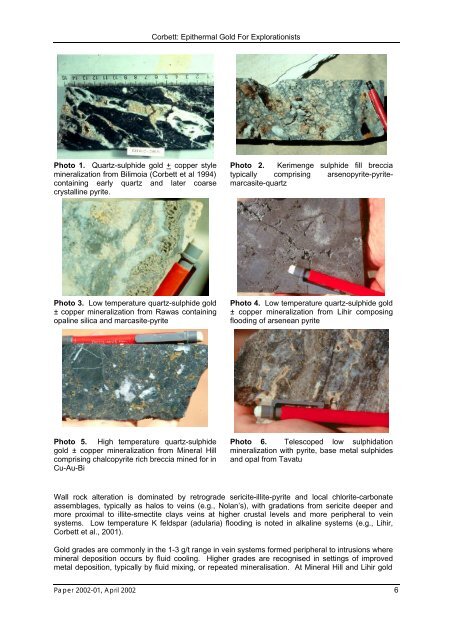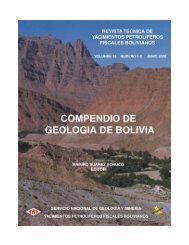Exploraciones por oro epitermal
Create successful ePaper yourself
Turn your PDF publications into a flip-book with our unique Google optimized e-Paper software.
Corbett: Epithermal Gold For Explorationists<br />
Photo 1. Quartz-sulphide gold + copper style<br />
mineralization from Bilimoia (Corbett et al 1994)<br />
containing early quartz and later coarse<br />
crystalline pyrite.<br />
Photo 2. Kerimenge sulphide fill breccia<br />
typically comprising arsenopyrite-pyritemarcasite-quartz<br />
Photo 3. Low temperature quartz-sulphide gold<br />
± copper mineralization from Rawas containing<br />
opaline silica and marcasite-pyrite<br />
Photo 4. Low temperature quartz-sulphide gold<br />
± copper mineralization from Lihir composing<br />
flooding of arsenean pyrite<br />
Photo 5. High temperature quartz-sulphide<br />
gold ± copper mineralization from Mineral Hill<br />
comprising chalcopyrite rich breccia mined for in<br />
Cu-Au-Bi<br />
Photo 6. Telescoped low sulphidation<br />
mineralization with pyrite, base metal sulphides<br />
and opal from Tavatu<br />
Wall rock alteration is dominated by retrograde sericite-illite-pyrite and local chlorite-carbonate<br />
assemblages, typically as halos to veins (e.g., Nolan’s), with gradations from sericite deeper and<br />
more proximal to illite-smectite clays veins at higher crustal levels and more peripheral to vein<br />
systems. Low temperature K feldspar (adularia) flooding is noted in alkaline systems (e.g., Lihir,<br />
Corbett et al., 2001).<br />
Gold grades are commonly in the 1-3 g/t range in vein systems formed peripheral to intrusions where<br />
mineral deposition occurs by fluid cooling. Higher grades are recognised in settings of improved<br />
metal deposition, typically by fluid mixing, or repeated mineralisation. At Mineral Hill and Lihir gold<br />
Paper 2002-01, April 2002 6
















